#hollow knight essay
Explore tagged Tumblr posts
Text
What is with the Dreamers' Houses?!?! Monomon's Archives
Okay, we can all agree that Team Cherry put a LOT of thought into crafting the backgrounds and environments of Hollow Knight. But why is nobody talking about the designs for the Dreamers' houses?! Especially compared with their base forms? Well, let's start talking about it!
Behold! Monomon's Design!
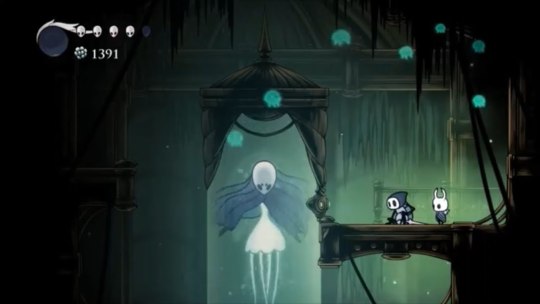
Taken from Monomon-the-Teacher.jpeg (1280×720) (punishedbacklog.com)
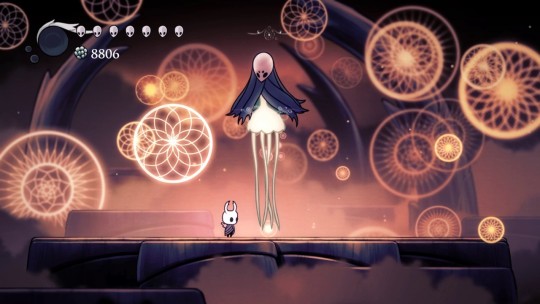
Taken from: https://i.ytimg.com/vi/Yn7QtF-wkSY/maxresdefault.jpg
When you meet the Teacher, the first reaction is either "She's beautiful…" or "WHAT IS A JELLYFISH DOING IN A KINGDOM OF BUGS????" If one isn't your first reaction, then it will most certainly be your second.
I could go on about how Monomon pairs her elegant beauty with her mysterious origins, but then I would be repeating words all day. Let us pause and consider how Monomon, as THE Teacher, would teach Physics…while defying them. It isn't too much of a stretch to say Monomon would float outside of her tank when the all the other Jellies in game do.
Next is her Archives that to my knowledge, lacks books.

We are immediately treated at the entrance of Monomon's Archives. The only word that could sum it up would be awe: awestruck due to the beauty and the mystery. Looking at Monomon's house from the front can't help but remind one of how Jane Austen would describe a character's house…and how the house perfectly matched the character.
Entering the Archives, we quickly guess that no one has been here in a long time.

But walk in far enough…

And you can't help but guess what an awesome place this must have been. Take a look at the detail!

The insane amount of knowledge stored here is amazing…and we're on the first floor!

Though we can't read most of it…and what we can read…

Why Monomon, why? Even STEM students need to be proficient in spelling. Source: my engineer brother.
Moving on, the pathway to Monomon's tank is very straight-forward. So much so that we never get a chance to see all of the Teacher's Archives. One point that strikes me is that we never get a chance to see any classrooms. We see Monomon as a researcher as noted by the Charged Lumafly tank and entry:

We know Monomon as a collector of information:

We even get glimpses of Monomon being a mad scientist by creating the Uomu, Oomu, and Uummu.

But the only sign of Monomon being a teacher is by her relationship with Quirrel and the name of her Archives. Unless I am missing something, (or we are simply not able to enter the classrooms) the Archives are more of a library and research center than a school. While I am of the mind that we simply do not see the whole Archives as we are so dead-set on getting to Monomon herself, it really says something about Monomon that we can only see the Madame as a Teacher in her relationships with others.
I would love to further this point, but this essay is for the Dreamers' houses, not necessarily the relationships the Dreamers had unless the relationships are implied in the housing designs themselves, such as the masks in Herrah's Den. Another essay would be required so the Dreamers' relationships can be given the focus and care they deserve.
Returning to Monomon's Archives, it is strange that of all the rooms we get access to, it is not ones that Monomon's students can enter. The pathway to Monomon's tank is blocked by acid.


Yet we are the ones able to see Monomon in her resting place.

Besides Quirrel. But Quirrel has a habit of getting into places most wouldn't dare enter. And it is fitting that Quirrel, Monomon's closest student, is the one to enter Monomon's inner sanctuary.
The Tech in the room is simply amazing and begs more study. Atlas, I fear I might have missed a great deal when it comes to the Teacher. If there is anything more, I hope another member of the Hollow Knight community will step up to fill the void, pun intended.
Now, let us discuss a resting place not for Monomon, but for the player.

Is not this place so elegant in its decay? The perfect symmetry and the framing of the moss ceiling…it is a terrible pity we could not see the Teacher's Archives in Hallownest's prime.
Moving past the pity, let me share a little detail. Team Cherry, when designing each location, placed signs of the ruler of said location in the framework of the place, usually in the fencing. For Teacher's Archives…

It's right at the bench! Which means Monomon is in charge!
The above statement, while made in good jest, possibly bears more weight than on a passing glance. We see no Hallownestian Seals or crests imbedded within the walls. There are also no King's idols or any item to be retrieved from the Archives. Everything in the Archives is centered around Monomon and her research.
This idea gives rise to a theory that perhaps the Teacher's Archives was not part of Hallownest, but rather neutral territory where ANYONE could come to learn about anything in peace. This would not be the first time in media where such a place existed. The TV show "Babylon 5" tells the story of a space station created as a place where the different alien races can learn about the other races in neutral territory for the purpose of creating peace.
To answer some objections, yes, "The Pilgrams' Way" does pass through Fog Canyon, but it also passes through Greenpath which technically belongs to Unn, not the Pale King. And the Archives is one of the few places that has its own, unique bench.
If the Archives is not part of Hallownest, what does this neutrality tell us about Monomon? If the Teacher's Archives is indeed neutral territory, it shows how much emphasis Monomon puts on knowledge being open to everyone as the purpose of the Archives is a place to store all the knowledge she collected.
But if Monomon was neutral, how did she get involved with the Dreamer plan? Simple. Monomon cared about her students. Monomon welcomed everyone from anywhere, and everywhere was infected by the Radiance. To save her students, the majority of whom came from Hallownest, Monomon became a Dreamer. Unfortunately, it was all in vain as the world fell into stasis as one by one Monomon's students either died or fell to the Infection. The Archives, where you could find anyone from anywhere in Hallownest, now only holds jellyfish…
Before we wallow in sorrow, let us escape to the City of Tears and to the final Dreamer. Wait for part 3.0 coming soon!
This is a part series to see if I can fit everything in. I hope you enjoyed Monomon's Archives!
Part 1.0: Herrah's Den : Here
Part 2.0: Monomon's Archives (You are here)
Part 3.0: Lurien's Spire : Here
Part 3.25: More of Lurien's Spire: Here
Part 3.5: Lurien's Spire: Pillows and Patriotism: Here
Part 3.7 Lurien's Spire: What is wrong with Lurien's Office?! Here
Part 3.8: Even, even More of Lurien's Spire: Secret Room: Click here
Link to essay on Ao3: Here
#hk lurien#lurien the watcher#hk monomon#monomon the teacher#hk herrah#herrah the beast#hk quirrel#hollow knight#hollow knight essay#essay
104 notes
·
View notes
Text

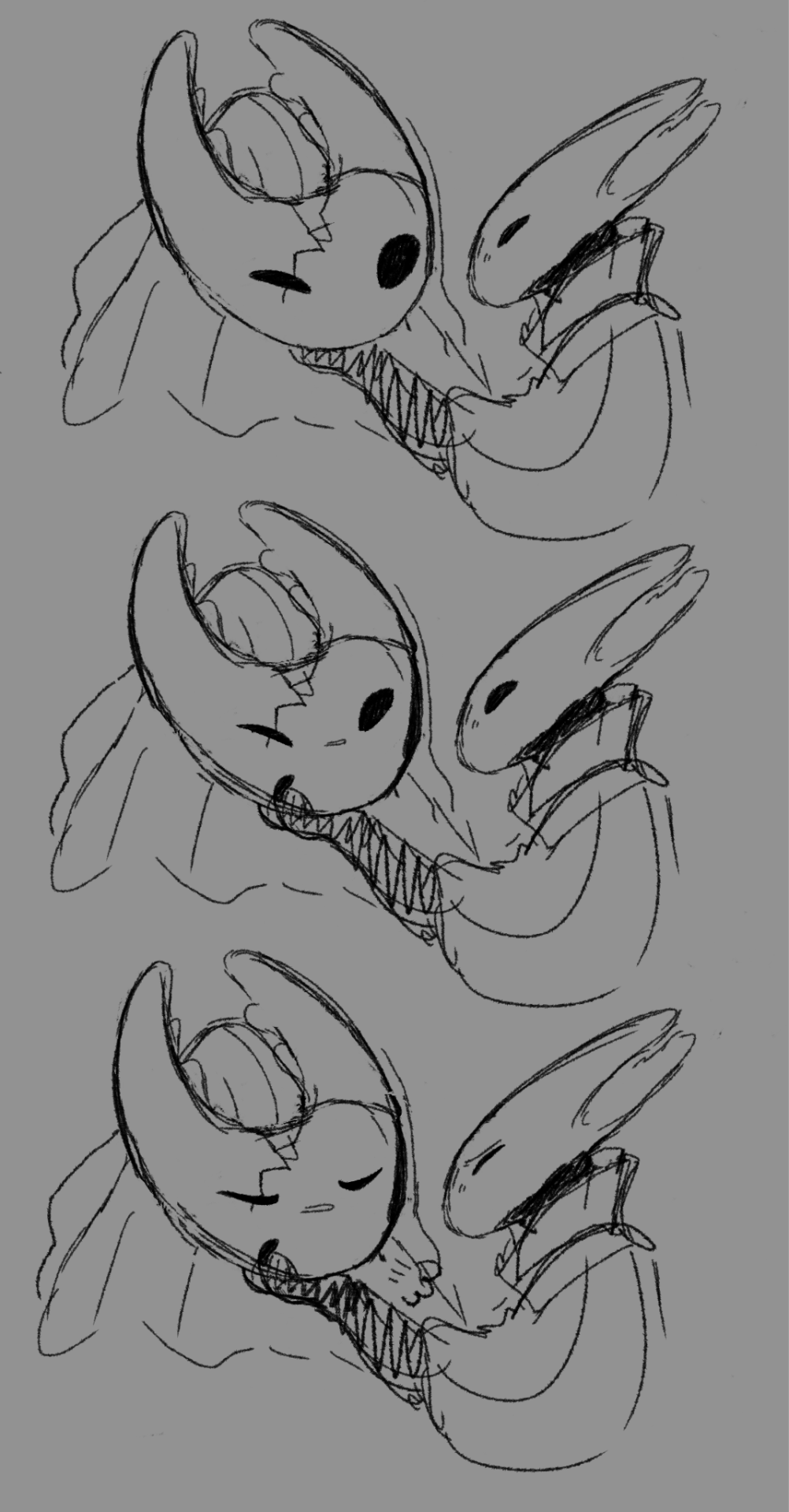



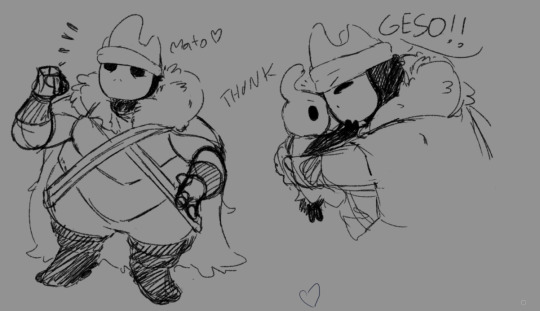

many thoughts about these guys
#hollow knight#hollow knight fanart#hk ghost#hornet hk#the hollow knight#the knight#nailmaster mato#i have a lot of thoughts about the sealed siblings and how they would necessarily grow#this is way way in the future since theres no way theyre not at least semi immortal#and hell some of my now making this post some of my takes changed but i have many thoughts about how theyd look how long itd take them to#be comfortable enough to settle and grow and accept all the shit thats happened and will happen#etc etc#feel free to pester me about specifics if ur curious ig i dont wanna write an essay in the tags sdjksd#enjoy my little goobers#side note all three of them like dirt and digging its good for worms and trees#sits in the dirt not unlike a tree and basking in the sun seems like a wonderful thing to do#but also playing in the mud and kicking puddles too#yea#my art
188 notes
·
View notes
Text
Ghost from Hollow Knight is disabled, and here's why
Obligatory disclaimer, of course, that this is just a theory. It may not even be what the creators intended! But it’s special to me, which is why I want to share if. And I think that a well crafted theory with textual evidence is far better than any inflammatory thumbnail by a YouTuber with enough charisma to overcome his utter lack of reading comprehension.
So, to start, I’ll explain the particular disability. Put simply, being filled with the primordial darkness soup has detrimental effects on one’s health. It takes the place of blood, but it’s more viscous, which means that the heart is constantly working overtime just to pump it properly.
So, what are the symptoms of this? Well, the most prominent one is this: Ghost is able to fully recover their health simply by sitting on a bench. If you’re wondering how that could possibly be linked to a heart condition, it’s actually based on my own experiences with POTS, Postural Orthostatic Tachycardia Syndrome. It’s a health condition that’s affectionately known as “can’t fucking stand disorder” or less affectionately known as other, more explicit things when it’s causing me trouble.
To get personal about my experience with POTS: I get dizzy standing up, or standing too long. I use a cane to support myself, and I need to drink what amounts to salt water to raise my blood volume. The blood volume is important, for reasons I’ll get into later.
So, on the surface level: they’re disabled because they need benches to recover. But bear with me, because I think it goes a little deeper and a little weirder. Here’s my theory.
Ghost was intended to be invincible. They don’t take contact damage. Every time they take damage, it’s actually just them flinching and their heart rate increasing.
I know, it sounds insane, but I promise that there is evidence to support this. The first piece is the Pale King’s ambition. He created everyone in the dead baby pit to be invincible, right? The perfect vessel to seal away the Radiance, no voice to cry suffering. But then we also know that the Hollow Knight themself wasn’t perfect. They were weak specifically because they wanted to be loved. They were weak because they had a heart, they had emotions, because their traitorous heart pumped blood too fast and it made them vulnerable, because they felt fear. It’s poetic, in a sense.
Diversity Loss! The dead baby pit created in a fruitless effort to save the remnants of a crumbling kingdom is made up of disabled bugs who were subject to a fuckshit eugenics experiment, yippee!
Another interesting piece of supporting evidence is the existence of Lifeblood. The heretic Joni pioneered its use, and there’s some weird implications that maybe this wasn't the best idea, but hear me out for a second. What if it’s literally increasing blood volume of our protagonist to give them some protection from the symptoms of what is effectively a goopy heart disease? The name is quite literal, actually.
The final piece of evidence? Look at the effects of the Fury of the Fallen charm. This one is like adrenaline overdose, complete with pulsing visual effects meant to set you on edge. While this charm is equipped, the knight won't even perform their idle animations. It's a small thing, but I think it is definitely meant to indicate that they're too pumped with adrenaline to have the focus to do this little things. All of that energy is dedicated towards not losing control, one way or another.
Overall, like I said. It’s not something I can prove, but it is backed up by some canon evidence. And it adds to the tragedy, I think, of a scared bug with a bleeding heart.
45 notes
·
View notes
Text
In honor of me having so much video game music downloaded on my phone that I ran out of storage and had to buy a new phone. My favorite track from each video game OST I have!
Bastion: Brusher Patrol (Such a bizarre clash of styles, I can't help but love this one. Shout-out to the part that sounds like Darren quietly scatting in the background.) (Also special shout-out to Build That Wall, probably my favorite vocal track in any Supergiant game)
Celeste: Scattered and Lost (I am such a normie for this choice but face it this track absolutely slaps.)
Chicory: A Colorful Tale: Song of the Wielders (I love how this song has actual lyrics but I still prefer to sing along with the Simlish version that Pizza and Chicory sing.)
The Cosmic Wheel Sisterhood: Illusion (First of all I love how every character in this game has their own theme I go feral for that kind of thing. Kurielle is probably one of the characters who stood out to me the least but by god is her theme gorgeous. I love the vocals and how a later track includes a sneaky reprise.)
Cuphead: Dramatic Fanatic (Tap dancing :D)
There are literally thirty of these so I'm doing a read more
Death's Door: The Grey Crow (A heartbreaking boss fight scored with the appropriate amount of anguish)
Deltarune: Cyber Battle (This melody is so underrated and ya know what, so are the characters associated with it. Sweet Cap'n Cakes forever.)
Elsinore: Donne, The Boat Boy (I love this song because it's associated with Lady Guildenstern, aka the best character in gaming full stop, but it's also just a fun little sea shanty that I think they made up for this game so I love that. Also has a lyrical version.)
Evergate: Police (Okay so the level with the police drones is one of the more frustrating ones in the game but the music is hauntingly beautiful so I give it a pass)
Going Under: trust fall (Marv is easily one of the most hateable video game antagonists of all time but damn if his boss theme doesn't slap)
Hades: Last Words (The rolling and the tolling of the bells bells bells bells bells)
Harmony: The Fall of Reverie: Reverie Ascendant (Lena Raine does these medley tracks so good man)
Hollow Knight: Dung Defender (By far the catchiest song about poop on my entire phone)
Ikenfell: Rose Thorns (So the insanely long final boss fight against Oxley overshadowed Aeldra's boss fight in my memory for a long time, but when I watched another playthrough and bought the OST I realized "Oh her theme bops SO much harder than his ever could")
Inscryption: A Final Duel (A hardcore remix of The Scrybe of Magicks, aka one of the only melodic tracks on the album and therefore the one every YouTube video about Inscryption uses in the background. I prefer the epic version just a bit more because honestly that Magnificus setpiece is the best moment in the game)
Jimmy and the Pulsating Mass: Fun, Sunny Day (A fun and silly track as the title suggests, elevated even more by the context in which it plays in the game. The area music alternates between this and the more somber Rainy Sunday to illustrate that Jimmy mother is bipolar [very cute and silly game])
Omori: Bready Steady Go (Like the absolute dipshit I am I actually completely missed the optional Orange Oasis when I played this game myself. Every Let's Player finds it somehow, though, and when they fight the Unbread Twins I invariably stand up and dance along to the boss music.)
One Step from Eden: Perpetual Motion (It's just a good-ass track y'all)
Ori and the Blind Forest: Conundrum (In a soundtrack of sweeping orchestral pieces, this more subdued version of theme that only plays during one small puzzle section might seem a weird choice. But I've always really liked it)
Ori and the Will of the Wisps: Kwolok's Malaise (Kwolok's leitmotif is perfect for a giant frog and the boss remix takes it to it's logical conclusion)
Paradise Killer: Go! Go! Style (This track makes me feel like I'm having a sugar rush. The whole OST does actually but this one especially)
Pyre: Path to Glory (It's just got a really unique vibe to it. I like it)
Scarlet Hollow: Avery (Chill and really beautiful. Avery themself is kind of a sleeper character at this point but I can't wait for Brandon to remix their theme when they get assimilated into a giant plant monster)
Slay the Princess: The Princess (Okay full disclosure I've only played this game once so I don't have the full context for a lot of the tracks on this OST. Maybe hearing them alongside their respective princesses will make me like them more, but for now the title theme is too iconic to beat.)
Sounds of Sympathy (the OST for the game anthology Essays on Empathy): Zen and the Art of Transhumanism (In the Essays on Empathy documentary, fingerspit talked about how she prefers writing obscenely long tracks so the loop doesn't get annoying. Unfortunately for her my favorite track on this album is only three minutes long. It's a lovely little bop.)
Spiritfarer: Mind Palace (I played Spiritfarer before any of the character updates were released, so I didn't get Daria's mind palace sequences in my game. And I mean, they look very platforming-heavy so I'm okay with that, but god this is a gorgeous piece.)
Transistor: Impossible (I think this is Royce Bracket's boss theme? I don't know when any of the tracks on this OST specifically play in game. Regardless of all that this one gets me pumped.)
Unavowed: One Man's Power (I couldn't find a video of this one, but it's gentle saxophone solo that plays when Logan Brown is introduced. I think it fits is character really well and just sounds really nice)
Undertale: Death by Glamour (Best song for best character, enough said)
Wandersong: Moonscape (God knows this game gave me a lot of great options to pick from, but I settled on this one because it's so uplifting.)
#bastion#celeste#chicory: a colorful tale#the cosmic wheel sisterhood#cuphead#death's door#deltarune#elsinore#evergate#going under#hades game#harmony: the fall of reverie#hollow knight#ikenfell#inscryption#jimmy and the pulsating mass#omori#one step from eden#ori and the blind forest#paradise killer#pyre#scarlet hollow#slay the princess#essays on empathy#spiritfarer#transistor#unavowed#undertale#wandersong
72 notes
·
View notes
Text
Obby and I are discussing the various Christian parallels that can be found in Hollow Knight and how they enrich the game's narrative. Typical Sunday activity for us tbh.
#The Radiance is an analogue to God's depiction in the Old Testament. The Pale King is an analogue to God's New Testament depiction in turn#the Hollow Knight is a Christ figure#In this essay i will—#hollow knight#hk#Sofie says stuff#obbyposting
24 notes
·
View notes
Text
youtube
Looking at the themes of Sacrifices and Souls in Hollow Knight and Ender Lilies!
42 notes
·
View notes
Text
i wish everyone who purposefully misgenders nonbinary characters goes to hell no matter what
#did you know there's mods for dr specifically to change kris's pronouns to not be they/them anymore . like this is something#people went out of their way to do#like. why. for what purpose.#i found this out because i clicked on a video essay for an entirely different mod out of curiosity and it STARTED#by mentioning one of these other pronouns mods as ''one of the best mods''#never clicked off a video so fast in my LIFE#every day i suffer in fandoms wherein the source material has a character go by anything other than he/him or she/her pronouns#and the fandom just cannot fucking handle it#can't watch any video ever on hollow knight or cotl or ut/dr EVER!!!!!!!!!!!!!!!!!!#EVERYONE EXPLODE. NOW!#clamtalk
20 notes
·
View notes
Text
youtube
new video out! it's about one of those games that i like, and also about living the present life w/o getting stuck in the past life. put it in your Watch Later if you don't have 6 minutes right now
15 notes
·
View notes
Text
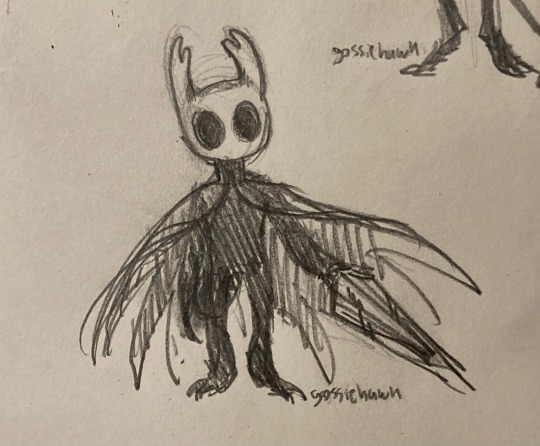


I’ve been playing this video game
#hk#hollow knight#art#my art#gossie draws#quirrel#tiso#anyway I cannot resist giving bug people digitigrade feets nor little buggy toeclaws#I should draw more of these guys….. not these guys SPECIFICALLY but hollow knight peeps in general……#:)#whatever the player character (ghost???)’s cape is doing in the first one is inspired by two things:#1. thumbnail of a video essay I’m saving for when I’ve finished the game on What exactly their capes are#2. combination of moth dash thing and monarch wings#:3
49 notes
·
View notes
Text
Which member of the hollow knight cast would write the Mario perchance essay if you made them write a paper? My money’s on Ghost with a very confused/frustrated Monomon as the teacher
#monomon: YOU CAN’T JUST SAY ‘PERCHANCE’#hollow knight#monomon the teacher#the knight#hollow knight ghost#Mario perchance essay
8 notes
·
View notes
Text
What is with the Dreamers' Houses?!?! Part 3.7 Lurien's Spire - WHAT is WRONG with Lurien's Office?!?!
Welcome back! Do you remember the last part where I was talking about how Patriotic Lurien was with all the Hallownestian crests?
I was about to leave it off here, until I realized something strange. There are no King’s Idols in Lurien’s Spire. Mr.-Certified-Pale-King-Fanboy has no King’s Idol from which he would worship the Pale King. What kind of fan would not have an idol or picture of his king? Especially in his bedroom!
Again, I was going to leave it even after checking the Hollow Knight wiki. Tumblr/Ao3 artist Aspidike already wrote a whole comic on it after all, so why should I spend time on it?
Looking back on it, I really should have spent more time wondering why Lurien has no King’s Idols to worship the Pale King when HERRAH is shown to be more religious than him. The Spider Queen has a Shrine inside her den while Lurien doesn’t even have a single idol or a chapel!
I only began to look deeper at the lack of King’s Idols in Lurien’s Spire when I realized there is something else missing in the Watcher’s Spire. Take a look at the carpet in Lurien’s Office.

Why does Lurien have purple carpet that completely covers the floor? Even wrapping around the pillars leading up to his Office? Why when everywhere else in his Spire has RED flooring and Hallownestian seals…

And that’s when it hit me. Not only are there no King’s Idols in Lurien’s Spire, but there is also nothing of the Pale King in Lurien’s Office a.k.a where he lays slumbering.
Look at Lurien’s Office again.




No painting of the Pale King, only that of the City. No massive window of the Hallownest Seal, only open windows. There are Hallownest Seals on the banners…but no Monarach Wings.
Please, allow me to explain the importance of the lack of Monarch Wings. Take a look down below at the kinds of Hallownest Seals seen across Hallownest.
The above photo is a drawing as I suck at photoshop.

Design 1 or the Seal design is most reminiscent of the Pale King with his Monarch Wings, hence why it will be often referred to as the Monarch’s Seal in this essay.
Design 2 or the Crest design is the most often seen crest design across all of Hallownest. It is the center or base that Designs 1 & 3 form their own designs on. I often take it to mean Hallownest itself versus the Monarch’s Seal which brings to mind the Pale King.
Design 3 is the design, which to my knowledge, is only seen in the City of Tears, especially on the noble’s side of the City. Originally, I called it Plumage Design and pondered whether or not this was an allusion to the Pale King, but now I believe it is a homage to the White Lady. See the comparison down below.


Part of the reason why I am making such a big deal out of the different designs is due to the Medieval heritage the game Hollow Knight draws on. If kings, knights, and keeping your oaths to your lords is greatly important to the game, then having a coat of arms and its impact are not a stretch. We already saw this in Monomon’s portion of the essay when we realized that Monomon was the one in charge of the Teacher’s Archives. Due to the lack of Hallownestian crests (or anything of Hallownest) as well as symbols in the benches being Monomon’s mask, we concluded that the Teacher’s Archives was not part of Hallownest proper, but rather natural territory under Monomon’s direct charge.
Having three different Hallownestain crests is vital. While the standard Design 2 or the Crest design allows one to tell that the messenger is from Hallownest versus the Mosskin, Designs 1 and 3 allow us to tell if the message came from the Pale King or White Lady themselves. The common Hallownestian official might only bear the Crest Design while servants in the White Palace bear Designs 1 & 3. Though I bet the Queen’s gardeners only bore the Plumage Design.
With this in mind, let us turn back to Lurien’s Spire to see which crests he bears throughout.



These are all locations through-out the Watcher’s Spire containing different versions of Hallownestian crests. Now please compare these with that of Lurien’s personal Office and Final Resting Place.



Here is the ONLY Place I found the 1st design or Monarch Seal in Lurien’s Office… If you actually can count it since it’s OUTSIDE his office.

The two places where the Monarach Wings appear in Lurien’s Office are in two locations that are OUTSIDE his office. The first is on the Spire’s wall which is just typical City of Tears architecture while the second winged crest is on the elevator. AKA, a standard design that is easily removed from the room.
What does this mean for Lurien, the fandom’s Pale King fanboy, with nothing of the Pale King inside his office? This is supposed to be Lurien’s personal space where there would be tons of Pale King merch and references. Yet, upon closer examination, not only are there no references to the Pale King, but Lurien went out of his way to hid any references to the White Lady as well! The purple carpet extends all the way down, hiding Design 3 or the White Lady’s crest!

Forget any blacklash from an shocked fandom, the lack of references to the Royal Couple in Lurien’s Office reeks of possible danger for the Watcher. Lurien is the 3rd most powerful bug in Hallownest, right underneath the Pale King and White Lady. Such massive influence needs to be massively watched and carefully checked to ensure that the Watcher doesn’t use that power against the Royal Couple. Yet the Watcher, in his own personal office, does not have any direct reference to either of them.
We do not know how the Royal Couple would feel that Lurien went out of his way to not show any direct alliegance in his private workspace and room.
Now, I already know what you are thinking. Lurien’s canon dialogue in the Dream Realm. “For King Beloved…to sleep and serve…” It seems as if all of his dialogue is suggesting the exact opposite picture of Lurien’s Office, that he put the Pale King above everything…but the Pale King isn’t the only reason why he became a Dreamer. To quote Lurien’s last journel entry:
“Sleep beckons eternal and these words become my last. Though my gaze shall no longer fall upon this city, I will act forever in its protection. For King, for bug, for Hallownest, I head now to my rest.”
Lurien is a poet. 2) His actions are for the forever protection of his City. 3) Lurien’s reasons for acting are not solely for the Pale King, but for bug and Hallownest. This is important as it shows Lurien separates Hallownest from the Pale King in his mind.
While Lurien DID say “For King Beloved”, there is nothing of Pale King inside Lurien’s personal Office. It seems like the care Lurien had for the Pale King was like the love Americans have for their flag, unwilling to let the flag touch the ground…but not going so far to have the flag inside their bedrooms…unless the love for the flag goes beyond patriotism to nationalism.
Finally, what does this lack of crests mean for Lurien’s character? I am afraid that I will have to dive into symbolism to explain as a certain Watcher doesn’t have much dialogue.
The lack of Monarch crest on the banners shows how Lurien always put Hallownest first, not the Pale King’s interests. Lurien could have snuck in one of the bigger banners with the Monarch crests, but chose the smaller banner with Design 2 to hang instead. Symbolically, this shows how Lurien’s heart with the kingdom first.
The lack of the Plumage Crests was brought about by Lurien redoing the floors, turning the red floor to purple carpet. As seen before in previous essays, the color red is associated with the nobles and the majority of the Plumage Crests are seen on the noble’s side of the City. Meanwhile, the color purple is primarily seen in Lurien’s Spire AKA Lurien’s color. Just as purple takes from both red and blue to rise to higher wisdom, inspiration, and humility, so Lurien rises above the roots to see a bird’s eye view of the whole culture of Hallownest, not just the nobles who grow (pun intended) from the White Lady.
The open windows has its own symbolism as Team Cherry could have given Lurien’s Office those magnificent Monarch crest windows. Instead, they chose to not just have no seal, but almost no window. Practically, this means Lurien can easily reposition his telescope anywhere so he can see everywhere in the City. But what about symbolism? The answer is that Lurien can see everything CLEARLY and without basis. He sees what is truly there, not what the Pale King wants him to see or expects him to see. Lurien isn’t even plagued by his own personal weakness or anger that could cause the glass to fog up. He can SEE.
Yes, Monomon. You can stop listing all the things wrong with the City. Lurien already has your list and THEN some.
Here we are at the end of this section and I cannot believe that CAREPT of all things would reveal how Lurien's loyalty is to Hallownest first, not the Pale King.
If you wish to read more of the Essay, click one of these links below.
Part 1.0: Herrah's Den : Here
Part 2.0: Monomon's Archives: Here
Part 3.0: Lurien's Spire: Here
Part 3.25: Lurien's Spire: Windows and Colors: Here
Part 3.5: Even More of Lurien's Spire. Here
Part 3.7: What is WRONG with Lurien's Spire? (You are here)
Part 3.8: Even, even More of Lurien's Spire: Secret Room: Click here
Link to essay on Ao3: Here
If you have thoughts you wish to share, please feel free to comment or reblog! Especially with the above observation!
#I TOLD you there was something weird with Lurien's carpet!#hk lurien#hk lurien the watcher's butler#lurien the watcher#hollow knight#hk monomon#herrah the beast#Finally get an appearance in Lurien's portion of an essay.#hk herrah#monomon the teacher#hollow knight essay#essay#fan essay#hk pale king#pale king's wings#pale king#the white lady#hk white lady
31 notes
·
View notes
Text
Tension, Flow, and Mastery in Action Games
Anyway here's my massive rant on game design, guest starring Mario, Kirbo, Ms. Celeste, Mr. Hollow Knight, John Miami, White (Neon Walter), err shove all night, and WELLTARO FROM HIT GAME DOWNWELL!!!
And Pizza Tower.
>------------------------------------<
I think that tension is the majority of what makes action based gameplay fun. Tension is derived from the need to make a move, particularly in deciding which one. Action games create higher levels of tension by giving the player limited time to make a decision, making the correct move uncertain, and judging how well they performed their actions. To examine further, I’m going to break down gameplay into four primary states. I’ll call them safe, hold, anticipation and window. Or shaw. That's a fun word, apparently it's synonymous with thicket.
Safe is when the player is completely safe, no tension. They could put their controller down and nothing would happen. When you’re on safe ground in a platformer, or behind cover in a shooter.
Hold is the equivalent of treading water, you’re holding a position, but you can’t stay there forever. The game generally requires that you do some simple action, like holding the climb button to cling to a wall in Celeste, or pogoing in Hollow Knight. When games try to pull extended tense sections, they often use this as the baseline to give the player time to think and recuperate, while ensuring that they know they aren’t out of the woods yet. Further this state often provides some kind of threat if they don’t get a move on. In Celeste clinging to walls drains an invisible stamina bar, and when you run out you’ll fall off to your death. In Hollow Knight you can technically pogo off a sawblade forever, but there's the unspoken threat of you messing up the pogo, screwing up the repeated simple action, and falling to your death, losing progress, so you better get to the next part before that happens.
The anticipation is defined by the player moving towards their next action. They can’t act yet, but sometimes the player is expected to line themselves up in preparation for when the anticipation state ends, which usually leads to the player finally having their window of opportunity to act, the time frame where they can actually perform their next action. Longer windows make pulling off the action easier.
For example a basic anticipation to window transition would be running up and jumping just before a ledge in Mario. If you jump too early you’ll fall into a pit, too late and the same will happen. If you pull it off during the window you’ll get across.
However anticipation does not always lead into window, for example when you’re descending from a jump onto a goomba, you use the anticipation to line yourself up, but there's no window. Once you land on him you’re set back to safe.
There’s many different ways action games use this kind of thing. It's fairly common for games that implement enemies as the primary hazard, like Kirby or Mario, to have the player turn the environment into safe zones as they go through. The player has to put themselves in anticipation and window as they say, dash towards an enemy to take them out, however they can do so whenever they please, because they’ve already cleared out all of the enemies behind them, and almost everything behind them is a safe zone.
On the other hand, some games space out their safe zones, giving the game most of the control over the pace. Thus the game can keep the pace cranked high to give the player less time to make decisions and make the gameplay more intense. Celeste and Downwell hold the implicit threat of falling to one's death over the player's head, having the player travel extended sections without being able to land on solid ground, increasing the tension by spacing out safe zones. Celeste allows the player to cling to walls for a decent bit of time, encouraging them to carefully plot out their actions but make a move before it's too late. In quite stark contrast Downwell gives gives the player a limited air stall ability, that can be used to hold them in place, allowing them to put themselves in hold temporarily, but the mechanic has many tertiary aspects in play to encourage the player to rely on it as little as possible, creating an intense adrenaline rush where you’re falling at max speed, pulsing the brake only as much as you need to steer.
Now, there's an interesting way this dynamic is changed when the player is forced to redo parts of a level. Maybe they got sent back to checkpoint, maybe they’re beating it again to satisfy a ranking system. Point is, when a player is made to repeat a level or part of a level they already beat, the way they approach it is different. I call it the flow to mastery transition.
The initial run is a pure flow run, what's important is that the player is unfamiliar with the path ahead of them, and they have to adapt on the fly. Their movement requires more care and planning. They make greater usage of the levels stills and holds to take everything in, and if they do not have control over the pace, then the tension spikes significantly such as in games like Downwell and Pizza Tower, as they have to use the few seconds the anticipation gives them to figure out their next move. The player's main focus is to avoid extrinsic flow breaks, which are factors outside of the core gameplay loop that serve as punishments for failure such as getting knocked back when you get hit and dying when that happens too many times, getting sent back to checkpoint, or the beginning of the level if you’re out of lives. The player needs to find a way through without dying.
The flow run begins a gradual transition to mastery the moment the player has to repeat an area, whenever they are sent back to checkpoint or the beginning of the level. The mastery is defined by the player using their preexisting knowledge of the level layout to try and find the most efficient route back to the new stuff. The player uses safe and hold zones much less, as they need to slow down less to take the level in, Safe and hold are treated as anticipation and window zones by the player, as they are much more likely to act as soon as the game lets them. Gameplay mainly centers around finding the perfect series of inputs to get through the set stage. The path to elucidating that series revolves around discovering the best route and picking out all of the little inefficiencies in gameplay.
The discovery is emphasized most when the player is uncertain of what the “correct” path, or the most efficient way through is meant to be. My mind flicks immediately to nonlinearity, more mazelike areas with many options, and we arrive at our first mastery case study, Hotline Miami. This game falls into the Celeste camp of 1 HP, checkpoints every five feet, trial and error your way through levels. As such the game puts all of its eggs into the mastery basket. The game is made up of a bunch of interconnected rooms, and you can hit up any adjacent one. Your goal is to hit up every room and kill everyone in it. Every death comes with the opportunity to either iterate on ones last strategy, or try a brand new one. If the player feels like they’ve hit a brick wall with their current strategy, they can choose to switch up the order in which they enter the rooms, and see if they can find a better one.
In addition to allowing the player to make their approach in any order they’d like, the game implements plenty of other tricks to increase the complexity and potential tension through new and uncertain choices of mastery development.
Guards are constantly on patrol, and if they stand beside a window or door you can get an immediate takedown. Should you wait for things to line up, barge in, or head for a different room. The important part is that the player has options, and that they are never forced to wait.
Further, the game implements what I’ll refer to as “soft blocks.” A hard block would be a wall, you can’t get through that. A soft block would be a long corridor with a guy wielding a shotgun at the end. You can’t get through there, with your fists at the least. You could go around and come in from behind, or if you grab a gun from another room you can blast him from the front.
The point is the player is provided with a number of complex choices they need to make, and a number of factors that make the optimal choice uncertain. They have many options, and all of them at least seem equally valuable.
The other interesting approach I’ve noted would be most prominent in Neon White. The game is a speedrun 3D platformer where you pick up guns represented by cards strewn across the level to shoot at stationary demons scattered everywhere, and once every demon is dead, get to the goal. Each level is designed for the player to initially blast through, then replay repeatedly to get a better time. Your first run will likely take you along the critical path. You see, the game takes place in a giant void, with a bunch of floating platforms everywhere. The player has many more options than just the ones that get them to the goal; they can get to any platform in jumping range, and many areas fill themselves with plenty of decorative platforms that seemingly only exist to make the place look nice. The critical path is communicated by the implied rules. The most famous example everyone likes to bring up is coins in Mario. They don’t do much, but the developer placed them in such a way that if you always follow them you should get to the end. Neon white uses demons and weapon cards in a similar fashion, where you’ll get to the goal with all demons defeated if you just follow.
Now, the reason this game is notable is because the critical path is rarely the fastest one. The game also throws in shortcuts. Shortcuts come from you defying the pointers outlining the critical path, and using the full extent of all options provided. You do not have to get every weapon, the only requirements for level completion are that you stand on the goal with all demons defeated. Further you do not have to get close to demons to defeat them, your guns are ranged weapons. The game just drills that mindset into you by placing cards and demons on the critical path. The player won’t have to go out of their way for extra weapons when they’re efficient with their ammo, and can skip parts of the critical path as long as their new route has line of sight with the demons.
The pointers give the level an immediate initial route, but with repeated attempts the player will gain greater understanding of all the options they have been given as their focus changes from simply getting through to getting through faster, and they will be able to discover the hidden shortcuts that rely on unused options placed throughout the level that the pointers constructing the critical path trained them to ignore.
In other words, to enhance the discovery of the mastery loop, you can either make your path an open maze, or a line with extra steps. As for the journey to perfection, to the perfect execution of inputs, there’s only one technique I know of to make that more interesting. I refer to it as intrinsic flow breaks.
Intrinsic flow breaks tend to be a short interruption worked into the core gameplay loop. They are less a failure on the players part as they are a measure of skill expression. While they have unique utility in individual games, they are generally used as something to minimize for speed incentivized players, but in both of these examples it comes packed with the bonus utility of making the game easier on your first try. They don’t necessarily have to stop the player, the main point is just that the player takes a small cut in speed.
Kirby makes for a pretty great example. In theory his ability to float over any obstacle should trivialize the majority of the game, however in practice the reduced speed from the float disincentivizes players from using it unless they absolutely need it. A metric defined by player skill where less confident players get an easy out of anything they can’t handle, while experienced ones use it as little as they can get away with so they can make good pace.
Pizza Tower shows what happens when you take a similar idea but crank the speed up to eleven. Peppino controls like a car with no brakes. Until you crash into a wall, you only ever go faster, so to help newer players get used to the games intense pace, intrinsic flow breaks are introduced. Moves where the player changes direction such as the turn around drift and super jump have Peppino pause for a moment before shiting direction, and allow newer players a second to get their bearings and break down the situation.
Pizza Tower likes to bake the intrinsic flow break into its catch all move for newer players, then add in more specific options that avoid the intrinsic flow break. For example you can avoid the pause during the super jump and turn around by choosing to climb walls instead of super jumping, or jumping off of them to turn around.
The way Pizza tower uses intrinsic flow breaks is especially notable because the methods to avoid them are context sensitive, they need a wall to pull off. They are not replacements, they are opportunities open to veteran players if they can spot them. They don’t change the gameplay, they build it up.
Other examples include having to punch enemies vs maintaining a toss combo in Gravity Circuit, bashing into enemies vs spinning through them in Anton Blast, whatever Plague of Shadows is doing. Made a whole video on that one.
Now, extrinsic flow breaks are what tie the flow and mastery together, so we’ll need to do a closer examination into extrinsic flow breaks in order to understand how flow and mastery play off each other. Just as a refresher, extrinsic flow breaks are the game's explicit failure conditions, such as getting hit and dying. They are what the player is primarily focused on doing during the flow run. Extrinsic flow breaks can be understood as two elements. The buffer, and the threat. The buffer is a degree of leniency the game extends to the player, allowing them to be inconsistent and still pass through. Most commonly expressed through health bars, their length is defined by the level of error and inconsistency the game is expecting and willing to let the player get away with. By allowing the player to slip up without losing progress, the constant introduction of unforeseen obstacles and by extension the flow run itself, is maintained. In addition, typically a degree of tension is added as their buffer shortens and they reach closer to the threat, which is of course what the game threatens to do if the player burns through their buffer. Usually sending the player back to checkpoint, it exists to demand a certain level of performance from the player. If the player's performance doesn’t match the difficulty curve, they’re made to repeat it until it does. The intention being that the increased skill from the practice will get them there, which develops mastery.
Now the following examples are just individual case studies. A small showing of games that use certain ratios of buffer to threat to accomplish a certain goal. They are in no way representative of the only thing that can be done with that arrangement.
Low health demands precision. In Mario games you have somewhat infrequent checkpoints, but also not terribly many hazards. The player has to be somewhat careful with their moves, but they aren’t expected to die terribly often, so the game doesn’t place checkpoints very often, as if the player does die they were likely either playing too risky, or had a simple mistake. Either way the player is unlikely to grind the level out, and the game focuses on easygoing flow. On the other hand Celeste only lets you get hit once and places spikes everywhere. As such it has to place a checkpoint down every couple of feet to ensure that the player keeps making progress. If the checkpoints were too far apart, then the player would surely master the first portion of the stage completely long before they even got close to the new stuff. The fun comes from the growth, but eventually the player is just grinding for a lucky run where they don’t screw anything up. The game ought to move the player along before that. Celeste can be a bit anxiety inducing at first, but when you repeat and practice the feeling transforms into a much more easygoing zen as the runs mesh together.
High health and somewhat frequent checkpoints brings to mind games like Shovel Knight and Hollow Knight, which have more focus on the player engaging the enemies with their combat mechanics as they traverse the world, and getting hit is a fairly expected part of the formula. Combat is a bit less precise compared to just platforming. Platforming tends to be about executing the correct path, while combat is more about avoiding and outputting damage. Platforming has very well defined anticipation and windows, whereas combat forces the player to constantly determine when it is safe to act through careful consideration of their current health, the enemies position relative to their own, lingering hazards, the opponents patterns, etc. The games have to place a fair number of checkpoints to catch the player if they fall in combat.
I can’t think of what high health infrequent checkpoints might represent from a general standpoint. Probably because the player would likely use the extra health to play riskier then die pretty far in and lose a bunch of progress, and that sounds very annoying.
The main issue I have with how extrinsic flow breaks are implemented with the traditional health and checkpoints system is that it’s rare that I find a game that can make both its initial flow and mastery development fun. Games that focus on flow often treat mastery as an obligation for players that can’t keep up. Without the considerations to extend mastery development, the player gets to perfection way too fast, and the mastery stops being fun. The mastery gets in the way of the flow.
On the other hand, games that put the development of mastery at the forefront lose the appeal of the flow by constantly interrupting the stream of new content with mastery development. I’d like a minute to take in all of the new stuff but the game keeps throwing me back to the start.
In search of a game that can pull off both, we come back to Kirby and Pizza Tower, as they both try to have their cake and eat it too. They try to make their flow accessible and easy to maintain and their mastery challenging with strong depth.
They put a lot of slack on the line, Kirby’s float will theoretically let you cheese anything as the player can just fly over any obstacle, ignoring the ability system will introduce a much simpler combat loop for boss fights, and the player is given a generous health bar. Peppino from Pizza Tower has infinite health, and can’t die until the escape sequence in every level, which does put the player on an explicit time limit, but gives them enough time to escape twice over. However, both of these games implement elements to incentivize experienced players to play faster, and tighten the restrictions for goals beyond completing the game.
Kirby goes the simple route and records the player's time. Oftentimes the game will implement side modes to show the player how fun it is to go fast. There will be obstacle courses and boss rushes that will give you medals if you can finish them under a certain time. The game knows it's more fun when you go fast, and tries to make sure the player gets that.
Pizza Tower has a more complex version achieved through its level rankings. In order to get the game's best rank, P, you need to meet a few requirements. You need to get a certain number of points by collecting objects throughout the level, complete all 3 secret rooms, grab the hidden treasure, complete a lap 2, and maintain a singular uninterrupted combo from the first room to the exit door. Your combo starts when you kill an enemy. It gives you seven seconds, and resets if you kill another. That means that you have to be constantly running as fast as you can to get to the next target before your combo runs out. On top of that, needing to do a lap 2 puts the excess time the game gives to newcomers to good use, significantly tightening the clock.
The most subtle mechanic however is likely the points dynamic. Points are received through killing enemies and collecting minor collectibles scattered through the level like coins in a Mario game. Smaller amounts are scattered in patterns to guide the player, but many more are hidden in big stashes throughout the level.
Because the smaller coin-like collectibles are intended to guide the player along the critical path, the player is going to miss plenty of them as they take shortcuts. This means that they’re already running tight on points, and if they need more they’ll need to find the stashes that can be collected most efficiently to make up for those lost points.
Further, the player can lose points through taking damage, and if they do they will likely have to get some of the less easy point caches placed later in the level, that may require the player perform a stylish trick or the like. The tension and challenge is enhanced by the fact that they haven’t been practicing that specific trick as they repeatedly attempt the level, which brings it much closer to the flow than mastery as the player needs to adapt to their slip up.
These games give the player a lenient formula, but ratchet up the challenge by having the gameplay radically change when you try to appease conditions that only veteran players will care about. Level rankings are about giving the game a broader range of appeal, as the player will either care, and go for the best one, or they won’t and waltz on through content with what they got. Games can keep their flow separate from their mastery development by splitting them into two separate experiences. This not only maintains the sanctity of the flow run, but makes the mastery development optional for those who strongly resonated with the game.
One method to do this that I didn't mention would be the pseudo New Game Plus, where you replay the whole game, same levels, but with a new character designed to speed through them. I know of three examples, Meta Knight from Kirby Super Star Ultra, Plague Knight from Shovel Knight: Treasure Trove, and The Noise from Pizza Tower.
To put it succinctly, Shovel Knight can jump 4.5 tiles horizontally and vertically; Plague Knight can fly. In fact all three of the mentioned characters are able to fly, in a platformer not designed around that. These games take characters with certain limits, design levels around those limits, then once you beat the game, let you replay those same levels as a character without those limits. This naturally increases the appeal of both the initial flow run and mastery development. The flow run is renewed as while you are somewhat familiar with the level layout, it’s been a while since you beat the first level, and further you don’t know how the new character navigates the first level. The mastery development is renewed because the level geometry has massively increased shortcut potential now that certain restrictions have been removed.
The new characters' much more expansive and freeing movement capabilities remove the emphasis of how the level wants you to navigate it, and places the emphasis on what your character can do.
#game design#video games#rant post#essay#super mario#kirby#kirby super star ultra#kirby super star#celeste#hollow knight#hotline miami#neon white#shovel knight#welltaro#from hit game#downwell#pizza tower#peppino spaghetti
15 notes
·
View notes
Text
youtube
Made a little video essay about Hollow Knight! It's called "The Hypnotizing Simplicity of Hollow Knight's Combat," and I explore the combat and what makes me love its simplicity (complete with a very unsubtle hitless NKG flex at the end)
4 notes
·
View notes
Text
Good morning!

I am EEPY and I have an essay due next week :(
I feel like these last couple weeks will feel like Path of Pain.
:(
#quirrel#hollow knight#hk quirrel#quirrel hollow knight#hollow knight quirrel#white palace#AAAAAAA#fuck them essays let me do creative writing#Spotify
14 notes
·
View notes
Text
HOLLOW KNIGHT IS ON SALE ON STEAM DUE TO CHRISTMAS. GO AND PLAY THE GAME OF THE CENTURY WHILE YOU WAIT FOR MY ESSAYS TO BE POSTED !!

#im sorry for the spam but PLEASE#i don't use my secondary blog at all. so.#i might make an essay regarding gods with it one day#PLEASE PLEASE PLEASE#hollow knight
15 notes
·
View notes
Text
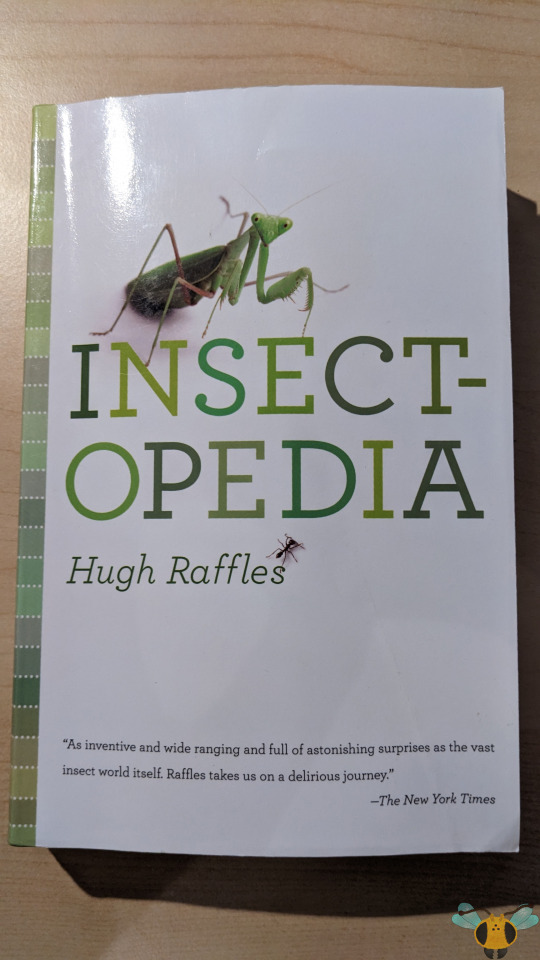




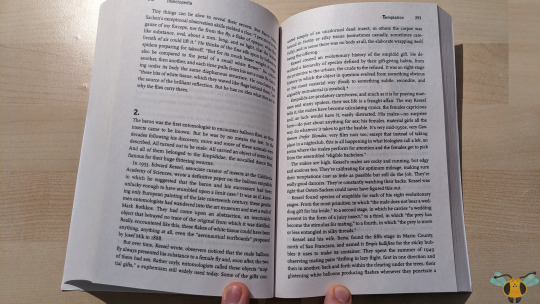

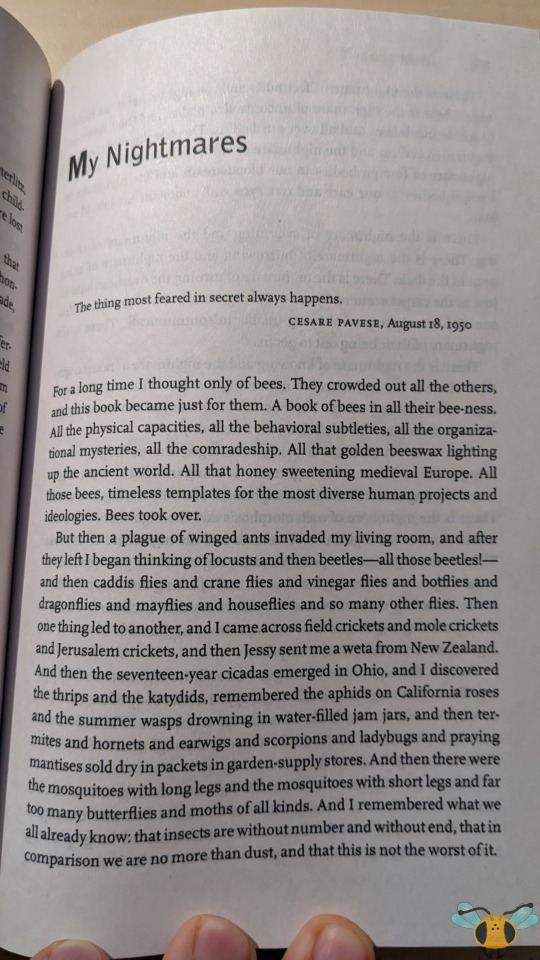
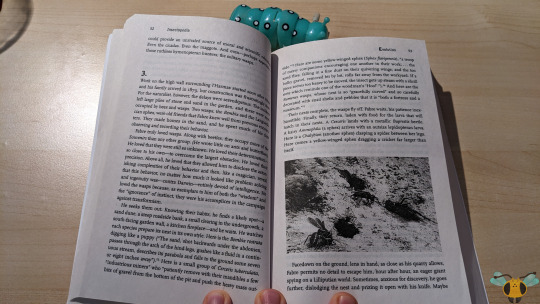
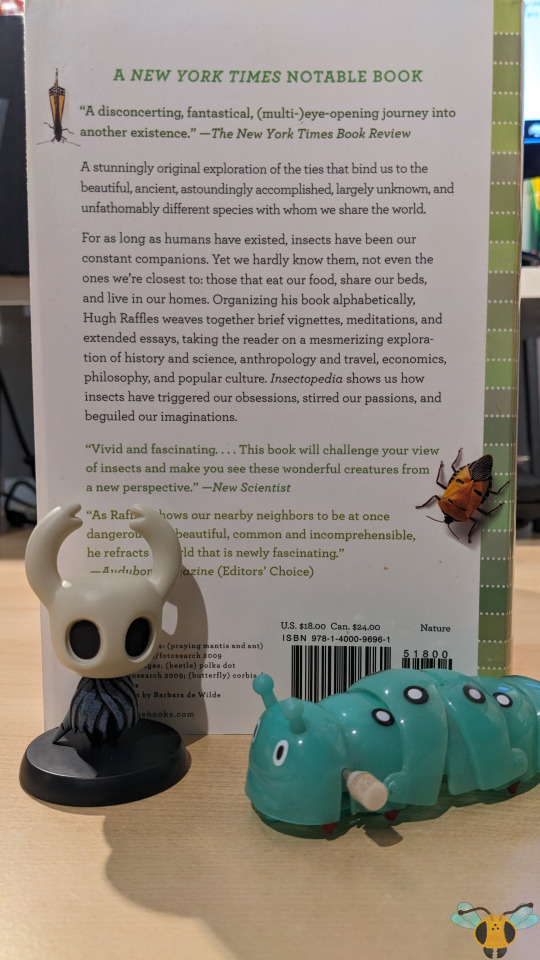
Insectopedia, by Hugh Raffles
Do not judge this book by its cover! Despite what the name would suggest, this is not a comprehensive encyclopedic volume that encompasses insect knowledge related to matters like species, classification, diets, orders and general factoids. No, no, this is a different branch in the world of insect exploration. The passages, stories and analysis of 'Insectopedia' are more philosophical, anthropological (based on human society and culture) rather than locked into a box of science and research (though they do play a big part of this book). Compared to the previous literature showcase, 'Sting of the Wild', this book is far more unconventional and explores a wider range of topics, but having read it twice now, I think it offers something that very few other works can. It's one thing to outline insect facts, research, discoveries and their place in the world; it's another thing entirely to examine how insects impact the world & humanity, how humanity impacts insects, how cultures, traditions and ideas can be shaped through our hexapod friends. This book embraces the eclectic and shares it as a multitude of essays and stories that truly highlight how curiosity and fascination can develop into passions, discoveries, introspections, livelihoods and in some cases, obsessions. This collection of musings and insight is also reinforced by a citation heavy note section and bibliography and countless anecdotes across 26 chapters (named alphabetically).
In a sense, it resonates like a collection of short stories or a scientific journal publishing with a great scope of content and findings to comb through. My personal favorite chapters are the ones on 'Languages' (see Picture 5) and the 'O' chapter (not pictured), which deserves to be experienced fresh. All I'll leave you with is the name of that chapter, 'On January 8, 2008, Abdou Mahamane Was Driving through Niamey...". Both are among the longest chapters this work has to offer, but there are many more bite-sized chapters that offer stories that are short and sweet. There's little to no connectivity between each chapter and though the material may bounce back and forth wildly and some chapters barely reference insects (though nature is still an important focus), reading earlier chapters will likely reinforce appreciation for the subject material in the later sections. All that said, I think this book would be best recommended for those entering high school or university and to those who like their material dry and matter-of-fact, but also engaging (somewhat like a passionate lecture). Once again, the subject matter is the onus for a small age-gate or maturity-gate for this book, but it is a small gate. In particular, chapters C, J, Q and S are intended for more mature readers, but if you can understand and handle the subject matter, great knowledge will be your reward (for example, Chapter 'C' is 'Chernobyl', featuring a woman who examines radiation-induced insect deformities).
I know I've been somewhat vague on the exact information that can be gleamed from Insectopedia, but this is a deliberate choice. The material in this book should be read with an open mind and there shouldn't be any spoiled surprises for the journeys and insights discussed from cover to cover. If you seek examples for the type of material this book has to offer, Pictures 3-9 offer the tiniest gate to sample what Insectopedia can offer (and as prefaced at the beginning of the book, "The minuscule, a narrow gate, opens up an entire world" - Gaston Bachelard). You will not find identification guides in it nor will you find ways to distinguish one insect order from another, but it may grant some enlightenment or stir passion, discussion or a curiosity to further explore the ideas presented within and how they've evolved since the book's publishing in 2010. This may provide a great starting point for any students in need of a thesis topic! I suppose Picture 10 (presented by the Knight and a glow-in-the-dark Caterpillar) summarizes it far better than I could. I may have expected something more conventional in the beginning, I am definitely recommending this book and I'll be reading it again after I explore some of the papers within the bibliography. For me, this was the surprise of the year, and while there are times where I think it may be to eclectic (nearing "all over the place"), I was exposed to many new areas of study and I appreciate the stories and points of view I would never have heard had I stuck to only the usual material.
For additional insect literature, you may visit the Blog Resources page.
#jonny’s insect catalogue#insect field guide#hugh raffles#insectopedia#hugh raffles insectopedia#insect pictures#insect facts#essays#literature#philosophy#field guide#nature#entomology#arthropods#essay collection#insects in culture#insect literature#insect musings#rambling#insect topics#insect toys#insect wind-up toy#wind-up toy#wind-up caterpillar#fangamer#hollow knight#hollow knight figurine#knight figurine#Alex Colvin knight mini figurine#hollow knight figure
16 notes
·
View notes